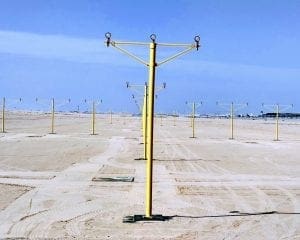Frangible masts now play a crucial role in various industries, from aviation to communications, sporting structures to streetlights. In all of the areas they are used, safety, reliability, and environmental considerations are of great importance. But with any large-scale installations such as these, there are bound to be difficulties. One of the biggest obstacles to installing these frangible masts is doing so in challenging environments. There are certain conditions that make installations more tricky, and they each require innovative solutions and careful planning.
Challenges in frangible mast installation
Remote and harsh terrain
Remote or harsh terrain, includes mountainous regions, deserts or coastal areas. Here, there are logistical challenges related to access, transportation of materials, and site preparation.

Environmental sensitivity
In environmentally sensitive areas like wildlife reserves or wetlands, there are additional challenges. These include minimising ecological impact, protecting habitats, and complying with environmental regulations while installing the masts.
Limited infrastructure
Lack of nearby infrastructure such as power supply, roads, or telecommunications can hinder the installation process. Additional resources for logistics and support services may also be required.
Extreme weather conditions
Challenging weather conditions include high winds, heavy rain, snow, or extreme temperatures. These can impact construction timelines, worker safety, and the structural integrity of frangible mast installations.

Safety considerations
Ensuring the safety of workers, contractors, and surrounding communities during installation activities is a big priority. This is especially the case in hazardous or remote locations with limited emergency response capabilities.
Strategies for overcoming challenges
Site assessment and planning
Thorough site assessments need to be conducted to understand the terrain. They’ll also identify any environmental constraints, the weather patterns, and infrastructure availability in the area. Detailed installation plans should be developed to consider logistics, equipment requirements, and safety protocols tailored to the specific environment.
Weather monitoring and contingency plans
Weather monitoring stations should be installed on-site to track weather conditions. This allows the implementation of contingency plans for adverse weather events that may affect installation activities. Mast installation should be scheduled during favourable weather windows. Ideally there should also be back-up plans in place for weather-related delays.
Environmental compliance and mitigation
Collaboration with environmental experts to assess ecological impacts is important. It allows necessary permits to be obtained. Plus mitigation measures can be implemented, including wildlife monitoring, erosion control, and waste management. The use of eco-friendly materials, construction practices, and post-installation maintenance strategies help minimise environmental footprint and promote sustainability.
Training and safety protocols
Comprehensive training to installation teams on safety procedures should be provided. The training should include equipment operation, emergency response protocols, and environmental compliance specific to the installation site. Regular safety audits should be conducted, including inspections and risk assessments throughout the installation process. This is to ensure adherence to safety standards and mitigate potential hazards.
How Pollite have provided solutions for challenging condition
Frangible mast installation in challenging environments requires meticulous planning, innovative techniques, and a strong focus on safety. Pollite are experts in the manufacture of fibreglass (fiberglass) and the design of frangible safety poles. We have great experience in designing and installing frangible masts in challenging conditions.
We provided fibreglass (fiberglass) approach masts for an airbase in the UAE . Our masts were required to withstand the exceptionally high temperatures that can be reached in the UAE. This fell within our standard product testing and approval to withstand temperatures of over 50⁰C. The masts’ gel coat is able to endure harsh UV light without changing colour or fading.
If your upcoming project exhibits challenging conditions for installations, partner with us. Call us now on 01325 355525 or email info@pollite.com.